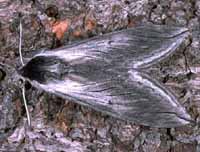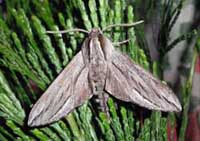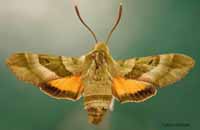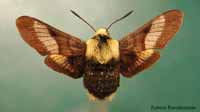Sphinginae subfamily
Sphingini tribe:
 |
This species is likely present and larvae feed on tomatoes and go by the common name of
"Tomato Hornworms". |
 |
If this species is present in Yamhill County, it is likely uncommon
as it is far from its more easterly/southerly range.
If you grow tomatoes, however,
you might encounter it in the garden as the moth is a very strong flier.
|
 |
Sphinx chersis *, the Northern Ash Sphinx or Great Ash Sphinx
The upperside of the forewing is soft dark gray to blue-gray with
a series of black dashes, one of which reaches the wing tip. |
 | The upperside of the forewing is dark grey to black with a
paler costa and pale area from the base to the wing's centre.
Prefered habitats include montane woodlands and mixed chaparral-type
vegetation. |
 |
This species is probably unlikely in Yamhill, preferring the
pinyon-juniper woodlands of California. It has been reported in southern Oregon
and also east of the Cascades. |
 |
The upperside of the forewing has a narrow black subterminal line
bordered by a white inverted V-shaped line on the outside, and a
black line running inwards from the apex of the wing.
It is most often found in montane woodlands and along streamcourses. |
Smerinthini Tribe:
 |
The grey-blue eyespot of the hindwing gives this species its name.
Larvae feed on birches, willows, cherries and oaks.
The outer edge of the forewings is quite scalloped. |
 |
If you have willows and poplars nearby, you've probably got populations of
the Cerisyi's Sphinx. The hindwings are quite striking. |
Macroglossinae subfamily
Dilophonotini tribe
 |
Hemaris thysbe WO, the Hummingbird Clearwing
This species might be present, but reports from nearby counties
may be confused with the more likely Hemaris diffinis. |
 |
Hemaris thetis WO, the Thetis Clearwing or Bee Hawk Moth,
The moth flies along forest edges and in meadows, gardens and
brushy fields. Day-flying adults nectar at lantana, dwarf bush honeysuckle,
snowberry, orange hawkweed, thistles, lilac, Canada violet, etc.
|
Macroglossini tribe
 |
Hyles gallii WO,
the Bedstraw Hawk Moth or Gallium Sphinx
This species is not officially reported from Yamhill County, but if you have
Gallium or Epilobium, you probably have populations of
this species. |
 |
Hyles lineata DM, the White-lined Sphinx
Dave McNeese sees this species regularly. It can be seen flying during the day,
into the evening and also at night.
The highly variable larvae are often found in people's gardens. |
Dave McNeese, May 3, 5, 8, 2005, 2 miles east of McMinnville.
 |
Although not officially reported from Yamhill County, this day flier,
April-June, prefering oak woodland and pine-oak woodland in foothills,
is probably present. Moths nectar at a variety of flowers in the afternoon.
|
 |
This species is not officially reported from Yamhill, but it is found to the east and
may be present. It nectars during the day in meadows near coniferous forests. |
|
|